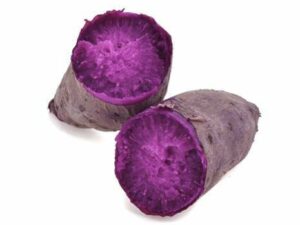

To many of us the terms sweet potato and yam are interchangeable; however, they are not the same. In fact, North Americans have been getting it wrong for generations. They may look similar but are two entirely different species and are not even remotely related! The true yam is part of the Dioscorea family and is related to grasses and lilies while the sweet potato belongs to Ipomoea and is related to the morning glory. The yam is an edible tuber native to Africa and Asia. The sweet potato, also an edible tuber, is native of South and Central America but grown in many parts of the world.
A simple marketing tactic has caused their names to be used interchangeably. In the early 1930’s, Julian C. Miller at the Louisiana State University Agricultural Center developed a variety of sweet potato which was larger, sweeter, and had soft orange flesh. To differentiate this new variety form those already existing, Louisiana sweet potato growers decided to market this new breed of orange-fleshed sweet potatoes as yams. The word “yam” is derived from the West African words “nyam”, “nyami” or “enayme” which mean “to eat”. Enslaved Africans were the first to refer to the sweet potato as a yam, as it reminded them of the ones they ate in Africa.
Tips to determine if it’s a yam or a sweet potato
Yams have a rough, scaly brown skin that is almost tree-bark-like in appearance and tend to be cylindrical in shape. Much like the regular potato, yams develop eyes or bud. Their flesh is dry, starchy and can range in color from off-white to red or purple with a texture similar to that of the yucca. Their flavor is generally mild and neutral, more like that of potatoes or yucca than sweet potatoes. Yams are toxic when eaten raw and must be cooked. They are extremely versatile, and the flesh can be fried, roasted, or boiled. Their leaves and stems are also poisonous and must be removed. Yams are high in carbohydrates with a decent amount of fiber, vitamin C, vitamin B6, potassium and manganese.
Yams grow in subtropical and tropical climates like Africa, South America and the Caribbean and are popular in the cuisines from those areas. There are more than 150 different yam varieties in the world; most of which are not sweet and have starchy white flesh, however, some reddish, yellow and purple cultivars do exist. One example is the Ube, or purple yam, which is popular in Filipino cooking and can be compared in texture and flavor to white russet potatoes.
Sweet potatoes are more closely related to the carrot than to the potato. They have a bulging middle with long tapered ends. Sweet potatoes do not develop eyes or buds but may have fine roots on their skin, similar to carrots or beets. Most common varieties of sweet potatoes have smooth orange or reddish skin with orange flesh. Their nutritional profile is similar to that of yams; however, they are higher in sugar, vitamin A and beta carotene. Although they can be eaten raw, their naturally sweet flavor is enhanced through cooking. The sweet potato can be roasted, steamed, boiled or fried. Like the greens from carrot or beet tops, the sweet potato leaves can be cooked.
Sweet potatoes are categorized as firm or soft. The firm type generally has pale skin and flesh and is drier and less sweet. The moister, sweeter soft type usually has darker skin and flesh and are those most commonly mistaken for yams. The sweet potatoes grown in the US range in color from yellow to red to purple and have pale yellow, orange or purple flesh. The copper-colored potato with orange flesh is probably more likely to come to mind when we think of sweet potatoes. More than 400 different varieties of sweet potatoes exist today. The most commonly found in North American grocery stores are:
The Orange Sweet Potatoes, commonly referred to as yams, are also called the “soft” sweet potatoes and have reddish-brown skin with bright orange flesh. The Jewel Yam (coppery-orange skin and dark-orange flesh, mildly sweet and earthy), the Garnet Yam (red-purple skin and orange flesh, more like pumpkin flavor) and the Beauregard (skin color ranges from copper, red-brown, to purple-brown with orange flesh, more deeply sweet) are popular varieties.
 The White Sweet Potatoes, known as “firm” sweet potatoes, have light, golden skin and pale flesh. Unlike the soft variety, this sweet potato remains firm and waxy after cooking. One of the most popular of the white variety is the Hanna Sweet Potato (light brown skin and off-white flesh).
The White Sweet Potatoes, known as “firm” sweet potatoes, have light, golden skin and pale flesh. Unlike the soft variety, this sweet potato remains firm and waxy after cooking. One of the most popular of the white variety is the Hanna Sweet Potato (light brown skin and off-white flesh).
 A third variety, the Japanese Sweet Potatoes is becoming a more common sight in US grocery stores. Their skin is deep purple or garnet colored with white flesh that turns buttery yellow when cooked. It is often referred to as Japanese Yam.
A third variety, the Japanese Sweet Potatoes is becoming a more common sight in US grocery stores. Their skin is deep purple or garnet colored with white flesh that turns buttery yellow when cooked. It is often referred to as Japanese Yam.
Since the yams sold in the US are technically sweet potatoes, the US Department of Agriculture requires that labels with the term “yam” be accompanied by the term “sweet potato”.
In reality, there isn’t much need to worry about mixing them up since true yams are not widely available in North America. They are usually found in stores that specialize in Latin American, Caribbean, Southeast Asian and African product.



Leave a Reply